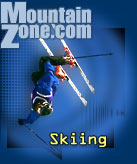
Powder Hunting
Searching for backcountry pow with Pacific Crest Snowcats
Lake Tahoe, CA - February 18, 2004

|
|
| Cat drops off skiers and boarders Photo by Alex West |
|
Lake Tahoe is known for steep terrain and sticky snow that spackles itself to every rock and rollover in the basin. It is also known for having the highest concentration of ski areas in the country. It is a place where many visitors stay in crummy, Cali-style, roadside motels and have to drive all over the place to get to the mountain in the morning. Tahoe has never been the fly-in-fly-out, furry boots amenity trove which has made its cousins in Utah, Colorado and B.C. so popular. Put it this way - you arrive in lovely Reno then drive an hour to get there.
But now new resort villages resembling the uber-malls of elsewhere (and being built by the same companies) are sprouting up in the 'Ho. The place is trying to walk out of the competitions' shadows and over time it may succeed. With the advent of Pacific Crest Snowcats out of Truckee, Tahoe's ski town envy is being hacked away at a little more - but with its own feel.
Steep Dance, Safety Dance, Corn-ucopia, the Diamond, Wood Shack Nose, Crown Jewel, Eagle's Nest, Fat Snag - these are all spots waiting for the bases of your skis in the backcountry between Squaw Valley and Sugar Bowl. The cat meets guests at a pullout near Truckee and Hwy. 89 then powers back about seven miles to access Pacific Crest's almost-2,000 acres of terrain. Guides give a demo of avalanche transceivers and everyone has to find a sunken beacon before heading off. Once the guides get a gauge for everyone's ability, it's menu time - they simply ask what you want to ski and Presto! you're there.
The day I go is bluebird sunny and with about five new inches of dry snow on top of a firm surface. It would have been hell at a resort, all bumped up and crusty. But back here where nobody has skied for almost ten days that smooth underlayer is, to borrow the owner's term, 'speed cream.' His name is Dave Rintala and he guides with Scott Samelson. They know the terrain so well it seems they must have grown up in these valleys. Their snow knowledge is almost uncanny as they tell us what's below, which sides of which gullies will slough a little bit, and where the deepest turns are to be found.
"We are able to drop off the other side of whatever ridge we're on and
have untouched, selfish, greedy swaths of pow..." |
"Every day all winter I want to know about the snow's metamorphoses. I'm all about the snow, it's my focus," Dave explains. He consistently checks snow and air temps as we ski around, writing everything in a little snotebook.
We ride a total of nine runs on five different slopes with aspects facing both north and south. They average about 1,200 vertical feet and most have meandering lower forest sections on the way to rendezvous with the cat. The variety is impressive and the pitches are diverse. We get onto some nice steeps with gullies, chutes and the occasional rockband. We also slide down gentle and wide open sheets of fresh. Since the terrain is below a main ridgeline, we are not exposed to huge cornices and major scouring. Nor do we have to negotiate tricky entrances to slopes. All of them have easy in's but with options for more difficult lines. We are allowed to ride any sections that won't slide, which is very liberating. We never get the feeling that our guides are holding us back. In fact, they always make a specific point to tell us what lies below not just for safety but also for challenging ourselves a bit.
Dave and Scott are very smart about 'farming' the terrain. Because they are so familiar with every slope they know when not to ski certain sections. This keeps the snow on the hill, reserved for when it's stable and ready. It teaches the average resort-goer two of backcountry skiing's biggest responsibilities: patience and restraint. The beauty is that these are lessons easily learned with Pacific Crest. We are able to drop off the other side of whatever ridge we're on and have untouched, selfish, greedy swaths of pow all to ourselves. And the thing to remember with all of this is that it can snow days before you go cat skiing and there is still plenty of fresh everywhere. Like terrain you find with good ole sweaty hiking, these backcountry slopes hold onto the best snow for a while. Less traffic and smart use of slopes means less skier-caused avalanching, less cutting-up of the snowpack and more untrammeled pitches.
